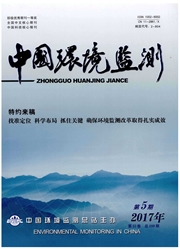

 中文摘要:
中文摘要:
为研究影响西宁市大气环境PM_(2.5)污染水平的主要来源,于2014年采暖季、风沙季和非采暖季依托西宁市大气地面观测网络在11个监测点采集大气PM_(2.5)样品,对其化学组分(元素、离子和碳)进行分析。研究同步采集了4类固定源、14类移动源和4类开放源的PM_(2.5)样品,并构建源排放成分谱。应用化学质量平衡受体模型(CMB)开展源解析研究。源解析结果表明,观测期间西宁市PM_(2.5)主要来源包括城市扬尘(分担率为26.4%)、燃煤尘(14.5%)、机动车尾气(12.8%)、二次硫酸盐(9.0%)、生物质燃烧(6.6%)、二次硝酸盐(5.7%)、钢铁尘(4.7%)、锌冶炼尘(3.4%)、建筑尘(4.4%)、土壤尘(4.4%)、餐饮排放(2.9%)和其他未识别的来源(5.2%)。大力开展城市扬尘为主的开放源污染控制,严格控制本地燃煤、机动车等污染源的PM_(2.5)排放,是改善西宁市空气质量的重要途径。
 英文摘要:
英文摘要:
In the study, PM2.5 samples were collected from 11 monitoring sites in Xining during the winter, spring and summer/ autumn of 2014 to investigate the major sources of ambient PM2.5 in the city. 4 types of stationary sources, 14 types of mobile sources and 4 types of fugitive dust sources were collected for source chemical profiles. Chemical compositions ( elements, water- soluble ions, and carbonaceous species) were analyzed for all PM25 samples. Chemical Mass Balance receptor model was applied for the source apportionment of PM25. Results indicated that the major sources of PM25 were urban resuspended dust (26.4%) , coal combustion dust ( 14. 5% ), vehicle exhaust ( 12.8% ), secondary sulfate (9.0%), biomass burning (6. 6% ), secondary nitrate (5.7%) , iron manufacturing dust (4. 7% ) , zinc manufacturing dust (3.4%) , construction derived dust (4.4%) , soil dust (4.4%) , cooking fume (2.9%) and unknown sources (5.2%). The result suggests that critical pathways of controlling PM25 pollution in Xining would be great managements and reductions on the fugitive dust, coal burning emission and local vehicle exhaust.
 同期刊论文项目
同期刊论文项目
 同项目期刊论文
同项目期刊论文
 期刊信息
期刊信息
